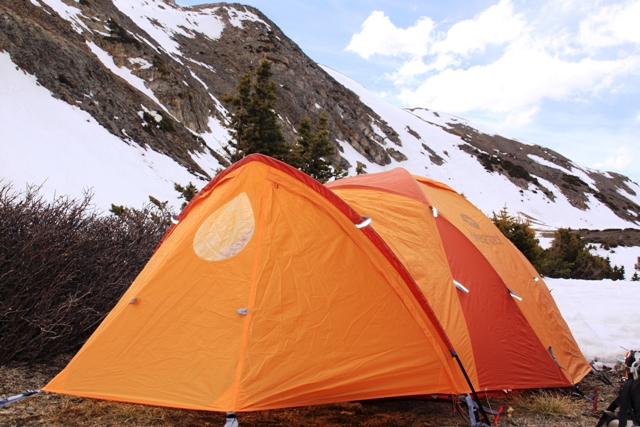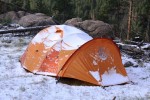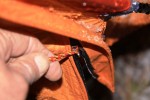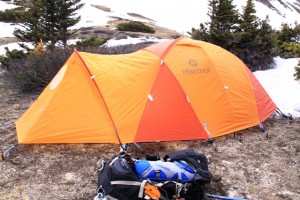
By Rick Shandley
Thor is the name Marmot gave to this benchmark four-season, all-weather, mountaineering tent. It proved to be a great name choice. Norse mythology described Thor as the god of thunder, lightning, and storms. The legend of Thor could have easily included unmerciful winds and wind-driven high-elevation snow in the description.
Well, the Marmot Thor two-person we evaluated lived up to every challenging weather condition we were able to get ourselves into during the late winter, early spring, and right up to rain and snow falls in early May.
When your adventure territory includes mountain ranges like the Rockies, Cascades, Sierra Nevada, Mogollons, or any upthrust granite rock formation around the world, the weather can get wicked complicated in a hurry. High winds, thundershowers, and dropping temperatures can even bring snow flurries in June.
Our test grounds were exclusively in the Rocky Mountains of Northern Colorado. We’ve had this Thor pegged to the earth at timberline, about 12,000 feet elevation with knock-down wind gusts and impending storms gathering above the peaks towering above the Eisenhower Memorial Tunnel of Interstate 70 where it crosses the Continental Divide.

Yah, baby, the winds could have blown this Terra Cotta/Pale pumpkin roll-caged bubble down to the chairlifts of Vail Ski Resort if it wasn’t nailed down. Good thing we had a grip on the ground in the rocky, still semi-frozen earth, with some sturdy DAC tent pegs and the DAC Dual Diameter Green pole frame structure.
One of the characteristics we really like about the Marmot Thor is the strength of the tent frame. It’s just the way those dual-diameter DAC pre-bent aluminum poles are designed to create a frame that supports pretty much every square-inch of the tent body and storm fly. It’s almost like a NASCAR approved roll cage. No kidding. Marmot uses the traditional X-frame structure as a core tent support, and then uses the best qualities of a tube-tent design by including three cross-brace tent poles to anchor the top-center of the Thor and both lengthwise ends of the tent. Add to that the pole-supported vestibule extension and you have a world class mountaineering tent.
Setting Up the Thor!
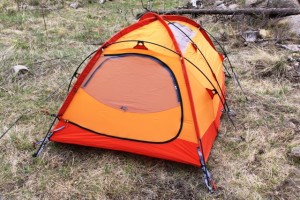
There are five primary tent poles, and a sixth pole-frame giving the outer edge of the vestibule roof structure and support.
On set-up, the first two poles create an X-frame that gives the tent body shape and primary support. Then three DAC tent poles cross the X to give the entire structure the kind of total strength that is said to be the strongest frame on the market. That would be a hard claim to dispute, as we experienced that strength in some scary winds. Under a snow load, this same strong frame allowed the Thor to retain its correct overall shape which remained taught.
We did experience a light snow load on the Thor. And the elongated dome shape of the Thor was able to shed snow build up on its own due to the design shape and the steep sides. And, from the inside of the Thor, it just took a couple upward hand taps to trigger the snow build up to slide off the tent during the night.
With just a few in-field tent set-ups, the sequence of assembling the Thor from a packed bundle into a ready to live in shelter becomes almost intuitive. It helps that the tent set-up instruction are always available on a pull-out flap sewn into the main tent stuff sack. But with a little practice set-up and take-down can go fairly quick.
Field Observations
The most recent outing with the Thor was on the eve of the Supermoon of 2012, the full-moon that appeared 30-percent larger than normal full-moon events. A significant spring storm was also moving into the Rocky Mountains, and you could see something big was building up. Folks that made their way up into the high country took off because the cloud cover and wind where shutting down the outdoor theater. No Supermoon show that night. Wind gusts got one’s attention late into the night.

Being inside the tent with the backpack gear gave some assurance there was sufficient weight to keep us on the ground. And the spot chosen to set the Thor was sheltered a little on both sides with dwarf pine trees. A four-foot-deep slab of snowpack was at the rear entry of the tent. So we thought we selected the best relatively flat spot we could to shield against the wind. Nonetheless, the wind howled like we were living in the jet stream. The Thor withstood some harsh winds, and we were as safe as we reasonably could hope for.
Early the next morning, the weather was fixing to revisit winter with high-elevation snow fall. It took less than 30 minutes to break down the tent and pack it up. There was some incentive, where we had parked the truck at the trailhead and the entire region at that elevation was looking like we either better get gone or be prepared to ride it out. This was in an avalanche prone area, so we high-tailed it. No cell phone coverage up there. No excuses for missing Monday morning work schedules, and nobody is going to come look for you during a storm.
Inside the Thor
Inside the Thor, we enjoyed ample room. The interior provides enough length and width to accommodate two adults in cold-weather down sleeping bags. Interior height of 43-inches is good for sitting up and moving around. If you are six-foot or taller, the Thor offers plenty of room for your body and gear stored inside.

Mesh gear-pockets are positioned on both sides of the Thor so each person can stay organized when they empty their pockets at night. A gear hook is located at the crown of the tent to hang a light. You also have an internal guy line system to double-down on structural support when the winds get epic, and you get nervous about going for that e-ticket ride down the mountain.
Although you’ll choose one of the two tent entries to have your vestibule entrance, it is a good option to have when two folks are sharing the tent. Each person can their own tent door. With the vestibule-end of the Thor, you can expect 10-square feet of useable storage space. When you are in wet, muddy, or snow covered ground, the vestibule is roomy enough to slip into the tent part way and take of your boots before getting settled into the townhouse.
In the photo gallery below, you can see an image of the airspace between the main tent fabric (coated 40d 100-percent ripstop Nylon) and the rain fly (40d ripstop Nylon with 1800mm Silicon/Polyurethane coating). That air space works awesome with the two roof-top ventilation openings and the interior oval mesh-barrier windows and mesh tent doors. Ventilation is super with the Thor. Even though each test trek with the Thor was in moisture-laden conditions, condensation build-up was not an issue. That’s huge. With personal insulation being down-filled, for the most part, our down sleeping bags and jackets stayed dry.
Noiseless and snag-free zippers throughout the Thor tent worked flawlessly, even with cold, crooked, fragile, many times broken, hands. The zipper system is a value-add feature that was thought out very well when Marmot product planners and tent designers chose to run with this setup. Most every aspect about the ventilation, egression (tent entry) and exit room works well.
Thor Versatility
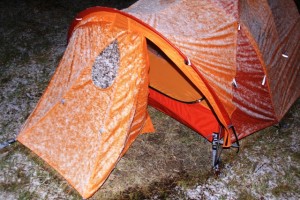
Yes, the Marmot Thor is a mountaineering tent by design. However, a tent built this sturdy can be used in any environment a backpacker is likely to choose as a destination, even if it’s an arid geography like the trails running to the bottom of the Grand Canyon. When your destination’s weather forecast looks like mild conditions, you can go super lightweight by using just the DAC poles, a footprint ground cloth, and the rain fly for an easy, strong, shelter.
With a MSRP of $499.00 U.S. dollars, you get value that will pay for itself in a season, whichever season you choose. You can invest a few dollars more and get the optional footprint ground cloth sized specifically for the Thor. With the footprint, you have extra protection under the full strength Thor, or you have something to protect your blow-up sleeping pad when you go ultra-light with just the pole system and the rain fly. I immediately saw the range of options Thor offers, maybe you will too.
Packed Weight

At a maximum packed weight of about eight pounds and a minimum weight of about seven pounds, the Thor is a significant weight consideration. Yet because the components of the Thor tent are compartmentalized (Stake/guy line/repair kit; DAC pole kit; tent body, and rain fly), you can share the pack weight with your tent partner. If your trail dog has its own pack, you can delegate the stake kit and rain fly to its burden.
In a large capacity backpack like the 65/85-liter pack I go to, the entire Thor can be broken down in component parts and distributed inside the backpack with nothing showing outside the pack. Also, I am able to fold and roll the tent body, and the rain fly, each into much smaller bundles than the 8×20-inch primary stuff sack requires.
The weight of the Thor is negligible (not important) to this writer. If Thor was a pound or two lighter, what would that weight savings do to the structural strength? The DAC pole system is second to none regarding tent strength, reliability, and longevity. The tent is a bomb shelter as far as mountain weather goes, so the weight is simply a fact to be packed, just like the water supply. Neither is light, but both are worth the weight.
Final Thoughts
What didn’t I like about the Marmot Thor two-person tent? That’s a question to ask if it ever failed. In the upper elevations above 7,000 feet, a solid four-season tent is the best practice in gear to have. In my view, this Marmot Thor two-person weather shelter lived up to the claims resonating from so many back country trekkers and mountaineers who count on the strength, durability, and ease of setup/take-down the Thor has delivered for them over the years this tent has been available.
And it’s little wonder why the Marmot Thor two-person and three-person tents have remained in the Marmot equipment lineup since it was launched years ago, because it is a sound structure that stands up to unyielding weather conditions.
- MSRP: $499.00
Features:

-
- DAC NSL Dual Diameter Green Poles
- Marmot Knees System
- Poled Vestibule – For Spacious Storage
- 40D Nylon R/S Sil/PU Fly
- Field Repair Kit – Extra Fabric to Fix Rips or Tears, Pole Repair Fleeve, Fly Buckle Back Up
- Bare Bones Setup – Allows the Fly to be Used by Itself with Footprint to Make a Lightweight, Sturdy Shelter
- Catenary Cut Floor – Fully Waterproof Floor with Taped Seams Lifted Off the Ground
- Internal Guy System – Dramatically Increases the Strength of the Tent in Gale-Force Winds
- Jingle-Free Nylon Zipper Pulls – Promote Undisturbed Sleep
- Knees Pole System – The Ability to Increase Internal Space Without Adding Weight
- Light-Reflective Points – To Find Your Tent At Night
- Optional Footprint – Extra Protection Under Your Tent or for Bare Bones Setup
- Pole Sleeve-Clip Combo – For Optimal Headroom, Increased Stability and Easy Setup
- Snag-Free Zipper Flap – Zip and Un-Zip Without Getting the Zipper Caught
- Two Doors – No Need to Crawl Over Your Tent Mate
- Unique Pole Structure – For Increased Stability and Increased Internal Space
- Welded Velcro® Attachments – Welded Velcro Attachments
- Window Weld™ – Waterproof Window Construction Reduces Weight and Enhances Appearance
Specifications:
-
- Colors: Terra Cotta/Pale Pumpkin (117)
- Maximum Weight: 8 lbs 6 oz / 3.8 kg
- Minimum Weight: 7 lbs 10 oz / 3.5 kg
- Dimensions: 43x56x93in / 109x142x236cm
- Packed Size: 8 x 20 in / 20 x 51 cm
- Vestibule Area:10 sq ft / 0.9 sq m
- Tent Poles: Six DAC NSL Poles
- Floor Area: 38 sq ft / 3.5 sq m
- Tent floor Material: 70d 100% Nylon 5000mm W/R, F/R
- Tent canopy Material: 40d 100% Nylon Ripstop, F/R
- Tent fly Material: 40d 100% Nylon Ripstop Silicon/PU 1800mm W/R, F/R

